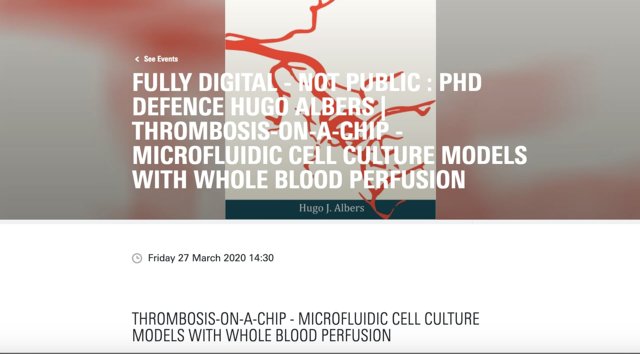Thrombosis-on-a-Chip - Microfluidic cell culture models with whole blood perfusion
Hugo Albers is a PhD student in the research group Biomedical and Environmental Sensorsystems (BIOS). His supervisors are prof.dr.ir. A. van den Berg from the Faculty of Electrical Engineering, Mathematics and Computer Science and prof.dr. P.C.J.J. Passier from the Faculty of Science and Technology.
 Cardiovascular diseases (CVDs) are the number one cause of death worldwide. The majority of CVD-related deaths are due to heart attacks or stroke, which are often instigated by thrombosis, i.e. the formation of blood clots inside of blood vessels. Therefore, both the academic world and industry seek to better understand, prevent and treat CVDs and thrombosis. However, the number of CVD-related deaths are still rising. Furthermore, the number of therapeutics in the drug development pipeline has stagnated and is disproportionately lower for CVDs in comparison to diseases with a lower burden on society, e.g. cancer or infectious diseases. The development of novel therapeutics is a long and expensive process, currently taking twelve to fifteen years and over one billion euros per new drug. At present, 80% of all drug candidates still fail in the clinical trials, often due to a lack of efficacy or unexpected side-effects. Regardless of the reason for termination, the high rates of late stage failure indicate a poor predictive power of the pre-clinical in vitro and animal models. Therefore, pre-clinical models that can reliably mimic human physiology and disease pathophysiology to predict the effects of therapeutics in humans are needed.
Cardiovascular diseases (CVDs) are the number one cause of death worldwide. The majority of CVD-related deaths are due to heart attacks or stroke, which are often instigated by thrombosis, i.e. the formation of blood clots inside of blood vessels. Therefore, both the academic world and industry seek to better understand, prevent and treat CVDs and thrombosis. However, the number of CVD-related deaths are still rising. Furthermore, the number of therapeutics in the drug development pipeline has stagnated and is disproportionately lower for CVDs in comparison to diseases with a lower burden on society, e.g. cancer or infectious diseases. The development of novel therapeutics is a long and expensive process, currently taking twelve to fifteen years and over one billion euros per new drug. At present, 80% of all drug candidates still fail in the clinical trials, often due to a lack of efficacy or unexpected side-effects. Regardless of the reason for termination, the high rates of late stage failure indicate a poor predictive power of the pre-clinical in vitro and animal models. Therefore, pre-clinical models that can reliably mimic human physiology and disease pathophysiology to predict the effects of therapeutics in humans are needed.
Organ-on-a-chip devices could be the answer to the need for technology that can mimic human response. Organ-on-a-chip technology relies on microfluidic technology to provide a realistic environment for human cells to be cultured. Furthermore, patient-specific cells can be incorporated which allows for a personalized approach. The use of patient-specific cells could improve the prediction of efficacy and toxicity during pre-clinical studies. Furthermore, it could lead to the implementation of a personalized medicine approach where a specific drug combination and dose is tailored for each patient. These microfluidic organ-on-chip devices have micrometer-size channels in which human cells can be cultured. Furthermore, similar biochemical cues can be applied as in standard in vitro tests but with the added benefit of control over physical properties like fluid flow and disease-specific geometries.
The aim of this PhD project was to develop new thrombosis-on-a-chip devices that can more realistically mimic human physiology and disease pathophysiology. To this end, various possible improvements were investigated with a focus on: realistic disease-specific geometries, the incorporation of hiPSC-ECs, a robust data analysis methodology and an approach to locally activate endothelium. These improvements to thrombosis-on-a-chip devices will bring them closer to being used routinely as pre-clinical models in the drug development pipeline. Furthermore, by incorporating person-specific cells, the models could potentially be utilized for future studies in personalized medicine.






